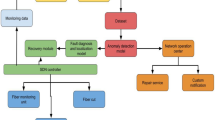Abstract
Safe and reliable data transport over optical networks is essential for a high-speed Internet. Optical fibres are the backbone of the Internet, allowing billions of people around the world to connect and exchange data. However, these cables can be compromised by both deliberate attacks and accidental damage. The disruption caused by these abnormalities may result in significant monetary and data losses, undermine the security of optical networks by enabling unauthorised parties to view the sent data, or progressively lower network performance. Based on an examination of data from optical networks, this research proposes an original strategy for hybrid machine learning-based network monitoring and security improvement. Here, an anomaly detection method called convolutional principal component network is utilised to keep an eye on the optical infrastructure. Then, we apply hybrid cloud vector Bayesian graph networks to fortify the system. Anomaly detection rate, accuracy, precision rate, and quality of service are all experimentally evaluated across a variety of security analysis datasets. We validate our research using data from operational networks and simulated data created in a realistic-looking simulator. The findings verify the efficacy of our approach for optimising routing decisions in real time and designing networks for the future.




Similar content being viewed by others
Data availability
All the data’s available in the manuscript.
References
Abdelli, K., Cho, J.Y., Azendorf, F., Griesser, H., Tropschug, C., Pachnicke, S.: Machine-learning-based anomaly detection in optical fiber monitoring. J. Opt. Commun. Netw. 14(5), 365–375 (2022)
Abdelli, K., Tropschug, C., Griesser, H., Pachnicke, S.: Fault monitoring in passive optical networks using machine learning techniques. In: 2023 23rd International Conference on Transparent Optical Networks (ICTON), pp. 1–5 (2023). IEEE.
Aibin, M., Chung, N., Gordon, T., Lyford, L., Vinchoff, C.: On short-and long-term traffic prediction in optical networks using machine learning. In: 2021 International Conference on Optical Network Design and Modeling (ONDM), pp. 1–6 (2021). IEEE.
Alwabisi, S., Ouni, R., Saleem, K.: Using machine learning and software-defined networking to detect and mitigate ddos attacks in fiber-optic networks. Electron 11(23), 4065 (2022). https://doi.org/10.3390/electronics11234065
Chen, X., Liu, C.Y., Proietti, R., Li, Z., Yoo, S.B.: Automating optical network fault management with machine learning. IEEE Commun. Mag. 60(12), 88–94 (2022)
Cho, J.Y., Pedreno-Manresa, J.J., Patri, S., Abdelli, K., Tropschug, C., Zou, J., Rydlichowski, P.: DeepALM: holistic optical network monitoring based on machine learning. In: 2022 Optical Fiber Communications Conference and Exhibition (OFC), pp. 1–3 (2022). IEEE.
Furdek, M., Natalino, C., Lipp, F., Hock, D., Di Giglio, A., Schiano, M.: Machine learning for optical network security monitoring: a practical perspective. J. Lightwave Technol. 38(11), 2860–2871 (2020). https://doi.org/10.1109/JLT.2020.2987032.
Furdek, M., Natalino, C., Lipp, F., Hock, D., Aerts, N., Schiano, M., Wosinska, L.: Demonstration of machine-learning-assisted security monitoring in optical networks. In: Proceedings ECOC (No. 1) (2019) ISBN: 978-1-83953-185-9, https://doi.org/10.1049/cp.2019.1189
Khadr, M.H., Elgala, H., Rahaim, M., Khreishah, A., Ayyash, M., Little, T.: Machine learning-based security-aware spatial modulation for heterogeneous radio-optical networks. Proc. R. Soc. A 477(2248), 20200889 (2021)
Panayiotou, T., Michalopoulou, M., Ellinas, G.: Survey on machine learning for traffic-driven service provisioning in optical networks. IEEE Commun. Surv. Tutor. 25(2), 1412–1443 (2023). https://doi.org/10.1109/COMST.2023.3247842.
Pandey, N.K., Mishra, A.K., Tripathi, N., Bagla, P., Sharma, R.: Implementation and monitoring of network traffic security using machine learning. In: 2023 2nd international conference on smart technologies and systems for next generation computing (ICSTSN), pp. 1–5 (2023). IEEE
Rengachary Gopalan, S., Chandran, H., Vijayan, N., Yadav, V., Mishra, S.: A machine learning assisted optical multistage interconnection network: performance analysis and hardware demonstration. ETRI J. 45(1), 60–74 (2023)
Silva, M.F., Sgambelluri, A., Pacini, A., Paolucci, F., Green, A., Mascarenas, D., Valcarenghi, L.: Confidentiality-preserving machine learning algorithms for soft-failure detection in optical communication networks. J. Opt. Commun. Netw. 15(8), C212–C222 (2023)
Song, H., Li, Y., Liu, M., Wang, K., Li, J., Zhang, M., ... & Zhang, J.: Experimental study of machine-learning-based detection and location of eavesdropping in end-to-end optical fiber communications. Optic. Fiber Technol. 68, 102669 (2022). https://doi.org/10.1016/j.yofte.2021.102669.
Szostak, D., Włodarczyk, A., Walkowiak, K.: Machine learning classification and regression approaches for optical network traffic prediction. Electron. 10(13), 1578 (2021)
Szostak, D.: Machine Learning Ensemble Methods for Optical Network Traffic Prediction. In: Gude Prego, J.J., de la Puerta, J.G., García Bringas, P., Quintián, H., Corchado, E. (eds) 14th International Conference on Computational Intelligence in Security for Information Systems and 12th International Conference on European Transnational Educational (CISIS 2021 and ICEUTE 2021). CISIS - ICEUTE 2021. Adv. Intell. Syst. Comput. 1400, (2022). https://doi.org/10.1007/978-3-030-87872-6_11
Wang, D., Zhang, C., Chen, W.: A review of machine learning-based failure management in optical networks. Sci. China Inf. Sci. 65, 211302 (2022). https://doi.org/10.1007/s11432-022-3557-9
Yan, B., Zhao, Y., Wang, W., Yan, L., Wang, Y., Liu, J., Zhang, J. First demonstration of machine-learning-based self-optimizing optical networks (SOON) running on commercial equipment. In: 2018 European Conference on Optical Communication (ECOC), pp. 1–3 (2018). IEEE.
Yang, H., Wan, Y., Yao, Q., Bao, B., Li, C., Sun, Z., Cheriet, M.: Anomaly prediction with hybrid supervised/unsupervised deep learning for elastic optical networks: a multi-index correlative approach. J. Lightwave Technol. 40(14), 4502–4513 (2022)
Zhang, L., Li, X., Tang, Y., Xin, J., & Huang, S.: A survey on QoT prediction using machine learning in optical networks. Opt. Fiber Technol. 68, 102804 (2022). https://doi.org/10.1016/j.yofte.2021.102804.
Zhang, C., Wang, D., Jia, J., et al.: Potential failure cause identification for optical networks using deep learning with an attention mechanism. J. Opt. Commun. Netw. 14(2), A122–A133 (2022b)
Funding
No funding.
Author information
Authors and Affiliations
Contributions
SR Conceived and design the analysis. AR Writing—Original draft preparation. MG Collecting the Data, VS Contributed data and analysis stools. DVK Performed and analysis, Wrote the Paper. AVN Editing and Figure Design.
Corresponding author
Ethics declarations
Conflict of interest
The authors declare that they have no known competing financial interests or personal relationships that could have appeared to influence the work reported in this paper.
Ethical approval
This article does not contain any studies with animals performed by any of the authors.
Additional information
Publisher's Note
Springer Nature remains neutral with regard to jurisdictional claims in published maps and institutional affiliations.
Rights and permissions
Springer Nature or its licensor (e.g. a society or other partner) holds exclusive rights to this article under a publishing agreement with the author(s) or other rightsholder(s); author self-archiving of the accepted manuscript version of this article is solely governed by the terms of such publishing agreement and applicable law.
About this article
Cite this article
Reddy, S., Rastogi, A., Gupta, M. et al. Utilizing hybrid computing models for network monitoring and security analysis through optical network modeling and data analytics. Opt Quant Electron 56, 180 (2024). https://doi.org/10.1007/s11082-023-05718-4
Received:
Accepted:
Published:
DOI: https://doi.org/10.1007/s11082-023-05718-4




